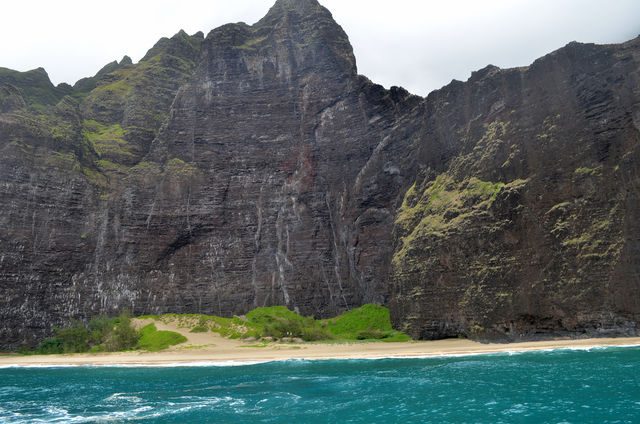Clouds hung low over the sheer Na Pali cliffs the day Holo Holo Charter’s 50-foot catamaran, Leila, skirted the edge of Major’s Bay and headed toward Kalalau Valley.
Rain was on the horizon and the roughly 20 people aboard knew it, but everyone was willing to brave the downpour to catch a glimpse of the spectacular coastline.
“On days when it gets pretty rough, we take a vote and if everyone’s ready to pack it in, we’ll head back early,” crewmember Max Watkins said as drops of water hit the top of the cabin.
A vote wasn’t necessary that day; everyone was in it for the long haul. The group was rewarded with only sporadic showers between sightseeing, sandwiches and snorkeling. The only thing missing was the sailing — the winds weren’t cooperating — but that didn’t dampen the spirits of most of the passengers.
“Seeing the Na Pali was one of the things we really wanted to do while we were here,” said Chris Teague, who was visiting with his wife, Ivonne, from California. “And you get wet snorkeling, anyway. It’s definitely worth it.”
Kellie Hughes, the captain at Leila’s wheel, said the tour is so popular that when they have to reroute because of weather, passengers often reschedule.
“We’ll gather everyone up in a group and tell them we have to go around the other side, and you’ll just see half of the group leave for the front desk,” Hughes said. “The Na Pali Coast is incredibly popular, but when you’re out here, you can see why.”
Mark Perriello, president of the Kauai Chamber of Commerce, said the coastline is one of the top attractions on Kauai. As such, it’s invaluable to the island’s economy.
“The visitors who come to Kauai to experience the Na Pali Coast have a direct impact on our local economy, as the vast majority visit and spend money exploring other parts of the island as well,” Perriello said.
The roughly 15-mile stretch of cliffs, the tallest of which is Kamaile Peak reaching 2,500 feet above Nualolo Kai, is mostly inaccessible due to those sheer cliffs that shoot straight up from the ocean. It’s only accessible by sea, air or via a grueling 11-mile trail that leads into the Kalalau Valley.
The scenic coastline has been featured in many magazines and served as the set for multiple blockbuster films.
“Whether travelers experience the coast by air, sea or foot, the majestic cliffs and sweeping vistas offer a beauty that is hard to match anywhere in the world,” Perriello said.
While it’s a golden egg for the economy and a scenic wonder, the Na Pali Coast is much more than it’s pretty face.
There’s a vast trove of archaeological and cultural treasure nestled within the cliffs, as it was where the first settlers of the Hawaiian chain landed their double-hulled outrigger sailing canoes sometime around 1200 AD.
Main activity was focused in Nualolo Kai, which is an old village site that has extensive agricultural features. It’s accessible today via boat and snorkel tours, but in its prime the area was a hot spot of economic activity between Hanalei, Waimea and Niihau.
“We estimate that Nualolo Kai could easily support 100 people, maybe more,” said Kauai kumu Sabra Kauka, an environmental educator and president of Na Pali Coast Ohana. “A lot (of the population) may have been seasonal.”
Today, stone-walled terraces, house platforms and temple structures can still be found in the valleys where the Hawaiians once lived. Ceremonies are held “to honor our kupuna as we return them to our place of origin,” Kauka said.
Currently, Nualolo Kai is curated by Na Pali Coast Ohana. The state also manages a little more than 6 acres in the center of the coast as the Na Pali Coast State Wilderness Park, which includes the Kalalau Valley.
In order to trek into the Kalalau Valley, hikers must secure a permit from the state Department of Land and Natural Resources. The trail traverses five major valleys before ending at Kalalau Beach.
It’s one of the planet’s more popular trails and it’s estimated around 150,000 people from around the world hike into the park annually.
Because it’s such a magnet for visitors, Perriello said he thinks it would be a good idea to create a national park around the area, even though the lands are currently protected by the state of Hawaii.
“This would likely increase visitor interest, and would come with funding from the federal government, which would further the economic impact on our local economy,” Perriello said.




